I have a large, and increasing, volume of information on this site. I know that can get overwhelming, so I have put this Executive Summary together to give people a place to start; a place where they can quickly get a sense of what a good swing (actually) looks like, how it works, and how to go about developing one. This Executive Summary follows the same general outline as the hitting presentations that I give to groups of people.
Another way to get an overview of the ideas that I discuss, and in the form of a PDF that can be downloaded, is via a couple of my eBooks...
My Story
Like most people, when my boys got older and I started coaching them and their baseball teams, I taught them what I was taught. That means the level swing, extension, and the Power V at the Point Of Contact.
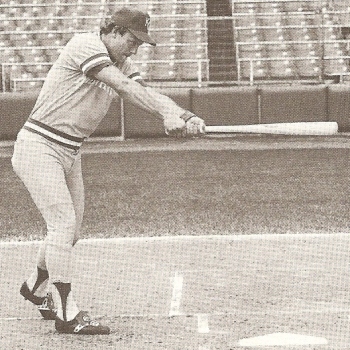
Level Swing, Extension, and the Power V
at the Point Of Contact
However, as I worked with the players on my older son's team, I found that they got worse and not better the more I worked with them. I eventually realized that I didn't know as much about hitting as I thought I did -- or that what I thought I knew was wrong -- and that I had to educate myself and learn what great hitters actually do.
Following a piece of advice that goes by the name of The Hanson Principle, I started collecting photographs and video clips of the best hitters. The more time I spent studying those photos and video clips, the more clear it became that great hitters do some very different things than I was taught and was teaching.
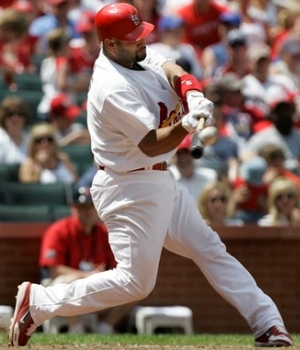
Albert Pujols
As part of my effort to understand the swings of good hitters, and because the way to see if you really understand something is to try to teach it to someone, I put together a number of flipbook analyses of the swing of Albert Pujols and other great hitters and then posted them to my web site.
In 2008, a career minor leaguer named Andres Torres stumbled across my web site. We then started talking about a number of concepts -- the most important of which was the concept of Connection -- and I helped him rebuild his swing and his approach.
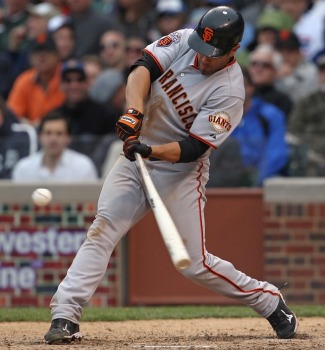
Andres Torres

Andres Torres
The result was a swing that helped the San Francisco Giants win the 2010 World Series and that we continue to work to improve.
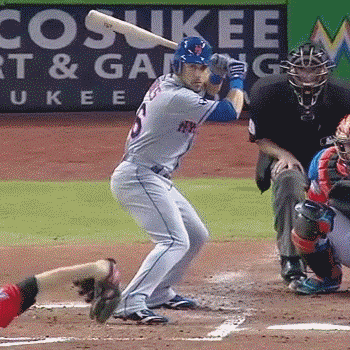
Andres Torres
Home Run to Right Field
10.3.2012
This site is my record of everything I've learned about understanding and teaching the High-Level Swing to hitters of all ages, including my own kids.

My Younger Son
6.7.2012
What a Good Swing (Actually) Looks Like
It's impossible to teach or fix a swing if you don't know what one looks like or how it works. As a result, I have put together a number of pieces that are focused on addressing the question of...
But Can a Kid Do That?
One question that always comes up when I start talking about the High-Level Swing with people, and with the parents of younger kids in particular, is whether it's worth -- or even possible -- to teach a kid the same thing that you teach major leaguers; whether a kid can do what the best hitters do given that most major leaguers are big, muscle-bound guys who spend hours and hours each day in the weight room and the batting cages.
As it turns out, I have a large and growing collection of pictures, like the ones below, that show just how closely the swing of a young hitter can resemble the swing of a major leaguer.
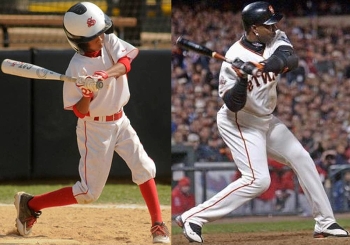
The High-Level Swing
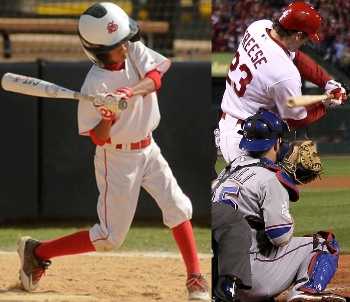
The High-Level Swing
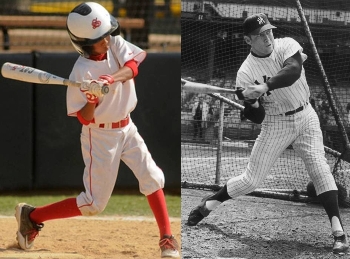
The High-Level Swing
The reason why kids, who aren't nearly as big as major leaguers, can still be successful with the same swing, and why they should be taught the same swing, is because kids generally don't swing wood bats and they don't play in major league ballparks. Instead, they swing lighter, aluminum bats and play in scaled-down ballparks. That lets them employ the same swing as major leaguers and enjoy proportional levels of success.
But Can a Female do That?
The next question that tends to come up is whether it's a good idea to teach the same swing to female fast pitch softball players. As it turns out, fast pitch softball has made the same accommodations to the differences between men and women, allowing women to use hotter, lighter bats and play in smaller fields. That allows women to use the same basic mechanics and enjoy comparable results.

Megan Bush vs. Albert Pujols
Also, while the trajectory of baseballs and fast pitch softballs are said to be very different, in truth there is no significant difference between the two sports when the hitters are swinging at pitches that are strikes.
First, Do No Harm
When it comes to developing a high-level swing in your hitter(s), you first need to understand that the odds are that everything you were taught, and everything that you think you know, about hitting is wrong. While you may have gotten lucky and had one of the few well-informed parents, coaches, or hitting coaches that are out there, the odds are against it. Instead, what's more likely is that what you were taught was not, and will not produce, the swing that you see in the clip below.
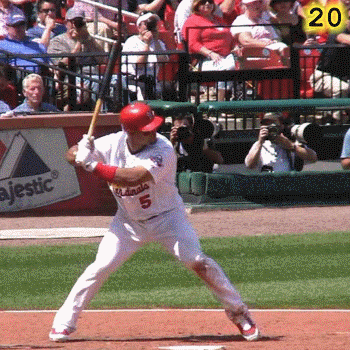
Albert Pujols
Home Run to Left Center Field
Middle/Middle Fastball
In fact, if you look at video clips of the best hitters, you will see that they do not do many of the things that people say are critical to the swing. In the clip above, which shows Albert Pujols hitting a home run to left center field and which should put to rest a number of misconceptions about the high-level swing, you can see...
- The Rotation of the hips ahead of the shoulders, not the hips and shoulders turning in unison.
- The front shoulder rotating open into contact, not the front shoulder staying closed.
- The barrel flattening down into the plane of the shoulders as the front heel plants and the shoulders start to rotate, not starting the swing with the barrel up.
- A Connection between the hands and the back shoulder and not Extension through the Point Of Contact.
- The Power L at the Point Of Contact and not the Power V.
- A Curved Hand Path and not a Linear Hand Path.
- The back foot off the ground at contact and not Squishing the Bug.
- The shoulders not staying level to the ground.
- The barrel dropping below the hands and not a Level Swing.
- The front elbow up, near the plane of the shoulders, and not down at the Point Of Contact.
Concepts
There are a number of concepts that you need to be familiar with in order to understand how a good swing works.
Rotation
Good swings are powered by the entire body and not just the arms and/or wrists. In particular, good swings are powered by the muscles of The Core and the Rotation of the hips ahead of the shoulders and the hands.
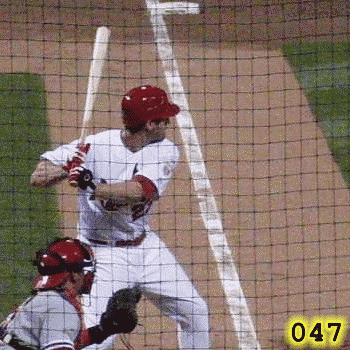
David Freese
Demonstrating Rotation
In the clip above of David Freese hitting a double to right field, notice how much his shoulders rotate before the barrel leaves the side of his back shoulder.
Separation
The Rotation of the hips ahead of the shoulders creates Separation between the hips and the shoulders. That stretches the muscles that run from the front hip to the back shoulder and boosts the force with which the shoulders rotate. It also gives hitters the ability to hit off-speed pitches.
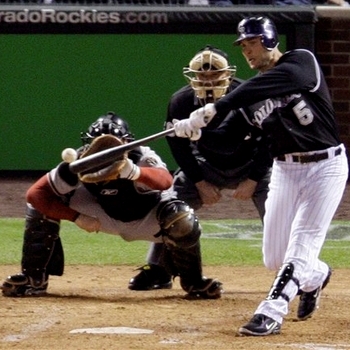
Matt Holliday
Demonstrating Separation
The picture above of Matt Holliday is one of the best examples of Separation that I have found. The thing to notice is how his hips are rotating ahead of his shoulders; while his belt buckle is pointing at the pitcher, his shoulders are still coming around.
Connection
The fact that the swing is powered by the Rotation of the hips and shoulders means that the arms, wrists, and hands have a very different role to play than most people believe. Instead of directly generating power by pushing the barrel to and through the Point Of Contact, in a good swing the arms, wrists, and hands indirectly generate power by maintaining Connection; by maintaining the position of the knob and the barrel relative to the rest of the body.

Barry Bonds
Demonstrating Connection
The picture above of Barry Bonds is the first one that all of the most knowledgeable instructors use to demonstrate Connection. The thing to notice is how, rather than throwing his hands at the ball or allowing them to drop, Barry Bonds' hands are up and back by his back shoulder.
Opposites
One way I explain the high-level swing is using a series of opposing concepts.
Connection vs. Extension
The most common word you will hear in association with the swing is the word Extension, as in extension at the Point Of Contact.

Extension at the Point Of Contact
However, if you look at pictures of the best swings of the best hitters, what you see is Connection and not Extension.

Connection at the Point Of Contact
Rotation vs. Linear Motion
While there is certainly a linear component to the swing -- the stride is usually a largely linear movement -- the fact is that the primary engine of a good swing is the muscles of The Core, facilitated by the Rotation of the hips ahead of the shoulders.
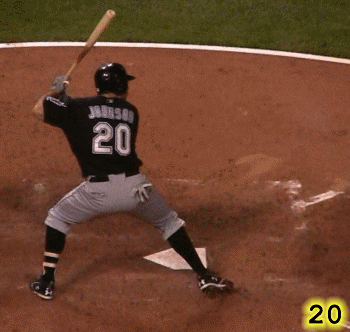
Rotation of the Hips Ahead of the Shoulders
Slight Uppercut vs. Level Swing
Instead of swinging level to the ground, the best hitters let the barrel drop below their hands so that they hit the ball with a Slight Uppercut. They do that by tilting forward over the plate slightly instead of keeping their shoulders level.
Model Swings
When teaching the swing to hitters, I typically do so using the swings of a few players, the first of whom is George Brett.

George Brett
George Brett had a very simple swing that allowed him to hit for both power and average. His swing was also nothing like the swing that he demonstrated in Charley Lau Sr.'s book, "The Art of Hitting .300."
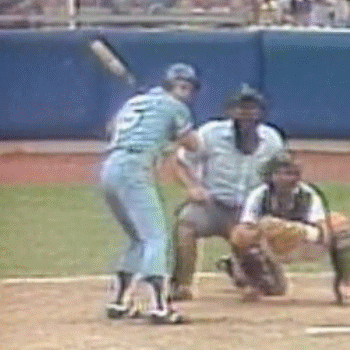
George Brett
Caitlyn Benyi, who played for UCLA, used a swing that was essentially identical to George Brett's.
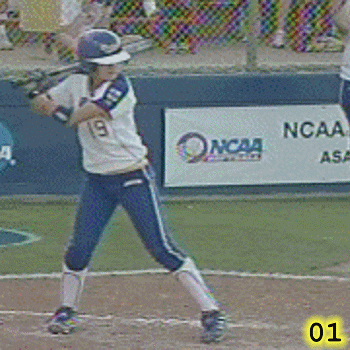
Caitlyn Benyi
The reason why I like the swings of George Brett and Caitlin Benyi, and why I use them as the base models for building a swing, is because they were both simple and effective. Notice how, rather than doing any fancy out of plane loading movements with the barrels or their arms, they start with their barrels fairly flat and in the plane of their shoulders and their hands and front elbow up and in the plane of their shoulders. They then just take a step forward toward the pitcher and rotate into the pitch.
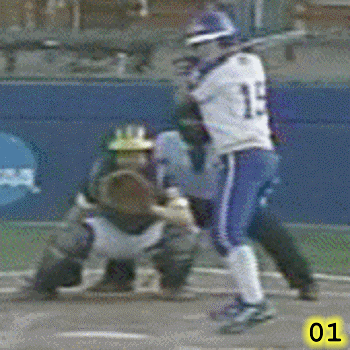
Caitlyn Benyi
When he's trying to hit the ball hard, but isn't trying to hit home runs, Andres Torres -- who is my highest-level client -- has the same basic swing.
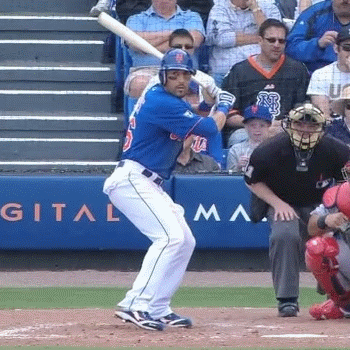
Andres Torres
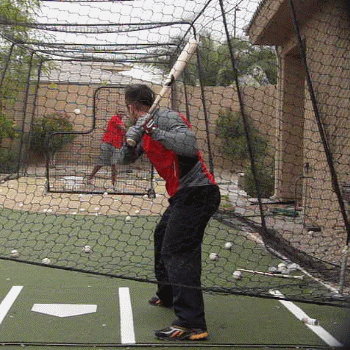
Andres Torres
One Basic Drill
The George Brett Drill is my go-to drill and the first drill I have most of my hitters -- and all of my younger hitters -- do in large part because so many hitters have a problem with Rotation.
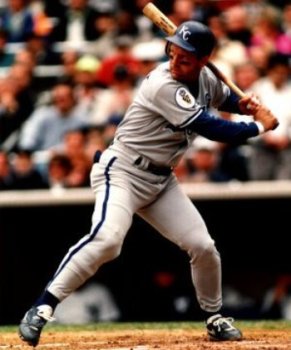
George Brett
Where to Go from Here
When talking hitting with people, I first like to touch on a number of topics...
I then like to give people an overview of what a good swing (actually) looks like...
I then get into a discussion of how to not ruin a young hitter's swing...
Finally, in my presentations I always get one or more questions about how my work compares and contrasts with the work of other hitting gurus. I have put together a number of pieces that address that question....